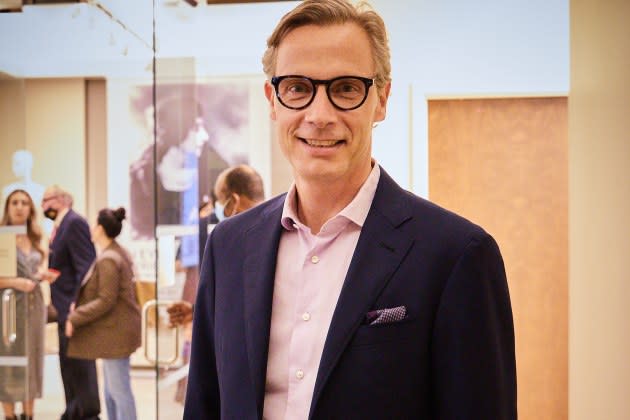Fashion CEOs Court Investors at Goldman Sachs Conference

While the chief executive officer is the ultimate decider on many high-level corporate moves, they are also front-line communicators, serving as the face of the company to employees, suppliers and — importantly — investors.
It was this last group that the CEOs of some of the industry’s most high-profile companies were speaking to at Day Two of the Goldman Sachs Global Retailing Conference.
More from WWD
Here’s the message fashion’s movers and shakers were looking to send at the conference.
Geoffroy van Raemdonck, CEO, Neiman Marcus Group.
There’s been a swirl of rumors and speculation on the future of Neiman Marcus, but according to van Raemdonck, “This is a business that has made choices and is midway in its transformation. The strategy is working, but there is more for us to unleash our full potential growth and growth that flows through the [profit-and-loss].
“There are a lot of rumors out there about potential acquisitions or divestiture, and while we don’t comment on rumors and speculation, what I want to make clear is that our shareholders are investing in the strategy,” van Raemdonck said.
He highlighted the $200 million invested in about one-third of Neiman Marcus’ 36 stores — a good portion is from landlords as well as brands building in-store shops — as well as into the supply chain for efficiencies, cost savings and speedier deliveries to customers. NMG also operates two Bergdorf Goodman stores and five Last Call clearance units.
Investments into NMG by the owners “will take time to pay off,” van Raemdonck said. But they are investments that short-term investors would not do, he added.
“They recognize the value of the assets, and their uniqueness, both NM and BG and there are a multitude of options they have,” van Raemdonck said, referencing what all funds look to do, make money on their investments. “There is no pressure to make any choice today and I think they are going to look at where the capital markets are and where the potential strategic or synergistic buyers are, but there is really no pressure and our focus is on the business.”
NMG is owned by Pacific Investment Management (PIMCO), Davidson Kempner Capital Management, and Sixth Street Partners. Farfetch has a minority stake.
That is a small group of investors, but van Raemdonck’s appearance at the conference signaled that he is also looking to communicate to the broader world of Wall Street.
Erik Nordstrom, CEO, Nordstrom Inc.
Nordstrom came to the Goldman Sachs conference with a kind of progress report of the retailer’s turnaround efforts.
“Past the midpoint of this year, we are really encouraged with the execution on our plan,” the CEO said, a few hours before the retailer unveiled a management shake-up. “The top line shows improvement…We’re ahead of our plan to deliver higher profitability.”
The Nordstrom Anniversary Sale had “really high sell-throughs,” he said.
Nordstrom said the company continues to see an “uncertain customer environment and softness across all income cohorts,” though business is better at the higher end.
The designer business has been “the fastest growing merchandise area for us for the last number of years,” he said. While there has been “some pullback” in demand recently, “We will still end the year ahead of 2019.”
Designer inventories will be in line by the end of this year and Nordstrom cited an opportunity within the designer business to broaden the offerings through more consignment and other inventory models that don’t have the risk of traditional wholesaling.
Virginia Drosos, CEO, Signet Jewelers
Signet has been in transformation for the last five years — investing in digital, tweaking the store fleet and updating its brand positioning.
Earlier this year, Drosos said the company moved its midterm goals a little higher as it was seeing “some really good traction.”
Higher price points offer one avenue to growth for the traditionally midmarket player.
“The big share gain opportunity for our company is the two-thirds of category sales that are dispersed among 17,000 independent jewelers,” Drosos said. “It’s a highly fragmented category. And typically, these independents play at a bit of a higher price point than us.”
To gain, Signet has been tweaking its offering at banners like Jared and has also acquired Diamonds Direct and Blue Nile, getting more exposure to the accessible luxury category. In all, the CEO said accessible luxury has “$1 billion of incremental revenue potential for us.”
James Reinhart, cofounder and CEO, ThredUp Inc.
While Reinhart sketched out the enduring opportunity in retail — which he described as “the fastest-growing sector in apparel” — he was also clear-eyed about some recent consumer challenges.
“What we’ve seen over the past six quarters is, yes, that budget shopper who maybe makes less than $60,000 a year… those customers are particularly strained across their personal balance sheet,” Reinhart said. “You just see less of them in market purchasing. And that was a big part of our business.
“I think we’ve done a pretty remarkable job of evolving away from being so concentrated on that customer really quickly to being able to target a slightly more affluent customer,” the CEO said.
“People are just buying on a deal,” he said. “You see it whether it’s travel, whether you see it in their leisure activities. And so I think in the apparel category, if it’s not on sale, like it’s probably not moving and I think that’s a lot of what you’re going to see over the next six to 12 months.”
Best of WWD

